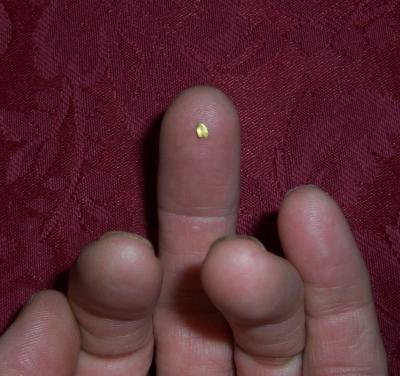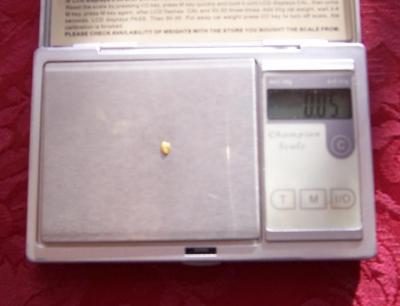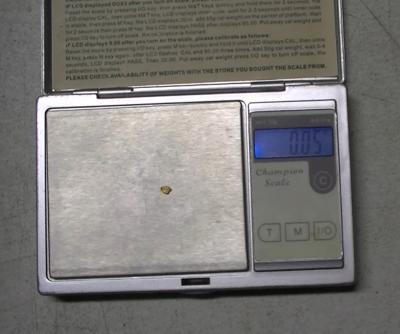
goldenoldie
-
Posts
167 -
Joined
-
Last visited
Content Type
Forums
Detector Prospector Home
Detector Database
Downloads
Posts posted by goldenoldie
-
-
I got one with a VLF (Gold Bug 2) last summer that ran 0.006grams. That is the correct number of zeros.
Wow any chance of a photo?
-
So I had a check back through my results to see what I had recorded as my smallest nugget find.
Well that turned out to be a 0.08 gram found with my previous GP 3000 using a Minelab 11” DD coil however my current GPX 5000 using a Commander 8” mono coil has now lowered that to 0.05 gram.
Just some further info on both nuggets and the 0.07 gram piece was found at Clermont's Bathampton GPA (General Permission Area) at a approx 1" depth with the GP 3000 set in DD/ Sensitive timing.
The 0.05 gram was found at Clermont's 4 Mile GPA at a depth of approx 2" (although hard to know when it popped out) with the GPX 5000 set in Fine Gold timing.
Actually both of the nuggets were real had to pinpoint when finally I got them out of their hole and in the dirt so had to try and locate it similar to how JP demonstrated on the 2300 coil.
JP would be familiar with the ground these came from as he would have detected these areas over the years of which I only visited when I was out that way.
Have yet to find any more of that size as the majority of the small gold if I find it now with the 5000 is from 1 gram down to 0.20 gram.
-
G'day all,
After watching JP’s latest video clip “SDC 2300 Child’s Play” displaying a very small nugget detected by the SDC 2300 with its 8” mono coil and it resting on the tip of his finger I tried to estimate what that nugget would weigh on a gold scale?
So I had a check back through my results to see what I had recorded as my smallest nugget find.
Well that turned out to be a 0.08 gram found with my previous GP 3000 using a Minelab 11” DD coil however my current GPX 5000 using a Commander 8” mono coil has now lowered that to 0.05 gram.
Just another pic of it on the scales maybe a little clearer.
Therefore with the SDC 2300 about to hit the market what is the smallest nugget that you have detected with either a PI or a VLF and hopefully a result will be posted here with a SDC 2300 also.
Thank you for your results.
-
As Reno Chris said Reg, it is good to see you posting as I have followed your postings over many years from here in Australia.
As I mentioned in Steve’s thread in regards to the new Minelab PI my main interest in this SDC / MPF detector would be IF it can produce any extra depth on small gold that lies beyond the GPX’s Fine Gold timing. I feel where I detect small nuggets in the 1 to 2 gram range are still at depths that are out of reach for Fine Gold even with a smaller coil.
I am NOT interested if the SDC is targeted at micro size nuggets but hey if it did away the need for a Wash Plant or a Dryblower than would I have a change of mind.
I suppose what size gold do we class as small, is it up to 1 gram, up to 5 gram or even up to 10 gram ?
Also I expect there is only so much you can do to a PI detector that it will only ever hit a certain size nugget at a certain depth and any extra depth on that nugget is up to using machinery or whatever means to remove the surface to another level.
-
I have a Minelab 3000 that was modified by Ishmael many years back and I have been using the Sadie coil with it lately, it is a small almost round mono coil that is produced by NuggetFinder Coils.
I have not found any places in which my 3000 could not handle the ground. You will however have to become familiar with what type of coil and size of coil to use in a particular ground situation. I hunt many diverse areas and choose to go with the Sadie coil because I have been able to find pieces of gold right at a grain, sometimes a hair smaller along with six or seven pennyweight nuggets at 16 to 20 inches in pretty hot ground.
You will notice that there is less EMI with a smaller coil, and many times the smaller right coil will handle the same hotter ground and still get you that three pennyweight nugget at fourteen inches. This is the exact reason I go with the Sadie.
That modified GP3000 is sure one hell of a detector from the results and depths you have achieved with the Sadie (8"x 6") coil. I am more familiar using grams for gold size so had to calculate how many grams in 6 or 7 pennyweights. Wow in pretty HOT ground to be able reach 6 or 7 pennyweight (9 and 10 gram) nuggets down at 16” to 20” including 3 pennyweight (4 gram) nuggets down at 14” is amazing especially I assume in Normal or Sensitive timing.
I own a Sadie coil also and yet to detect anything of those sizes at those depths with my 5000 and my best nugget so far with the 5000 was a 20 gram nugget at 16” in very hard compacted mineralised ground using a NF 24x12 mono in the Fine Gold timing. Even after placing the nugget back at the bottom of its now open hole I could only get an extra 1 inch of a response so tried Normal and Sensitive Extra for very little difference however both of these timings were too noisy to operate due to the mineralised ground.
My previous detector was a GP3000 and the best depth and nugget with it was a 10 gram (6 pennyweight) at 13” with an 18” mono using Normal timing.
With that modified 3000 I very much doubt any GPX with a Sadie Coil will match the depths on 4, 9 and 10 gram nuggets you are achieving with it in pretty hot ground.
-
Again, the problem is that as you get hotter on small gold the detector also acts more like a hot VLF than a PI. Building a hot PI is certainly possible but dealing with the problems that come along with doing so is a challenge.
When I was in Australia we did a little head to head hot VLF vs hot PI. The bottom line is the VLF got the tiniest shallow gold but the PI was able to hit a bit larger stuff deeper than the VLF could see. It takes the whole VLF vs PI thing down to a battle in the top few inches with both having strengths and weaknesses.
Thanks Steve for your reply and links in regards to my previous post.
One of the important questions I assume to be asked is how much of that battle as you say in the top few inches of ground would be won by this SDC PI over the most sensitive VLF and I expect the type of ground will have the say on that.
The battle for me is if the SDC2300 with its 8” coil can punch to depths greater on small nuggets in medium to severe mineralised ground than my GPX5000 in its most sensitive timing of Fine Gold with my 8” coil. That result I would have to rely on others to find out.
In regards to your VLF verses a hot PI an interesting observation from an interview between JP and Bruce Candy on air-depth test results and how accurate that result may be to what could be achieved in very mineralised ground then BC said the Smooth, Enhance and Fine Gold timings on a GPX can get within (98%) of their air-depth test result. BC then goes on to say a VLF in very mineralised ground may get only a quarter (25%) of their air-depth test result.
-
The potential exists not only for gold prospecting but micro-jewelry detecting.
It will be interesting to see if the SDC2300 as a “Pulse Induction” detector will be capable of detecting micro-jewellery as Steve has made mention in the above quote that I have taken from his posting on opening this thread. Pulse Induction does appear to struggle on this type of micro – jewellery.
Also I wonder if the SDC using its MPF technology will be capable of detecting thin tube of high grade stainless steel as used for hypodermic needles since Eric Foster said some time ago in a thread on Geotech that his fastest Pulse Induction detector at that time using a 1us delay with a 2.5 inch coil could not detect this type of needle.
-
In air, my ATX with sensitivity on 13 picked it up out to about 20". My SD-2100 with an 11" mono coil got it out to about 25".
That proves nothing, of course, but the ML is definitely deeper than the ATX by some noticeable margin.
Rick if your test with the ATX was with its standard 12" DD than I doubt the DD would be equivalent in size to an 11" mono so therefore I would expect an advantage using the 11" mono.
-
On January 16, 2014 at 7:10 PM, Steve Herschbach said:
There is the idea that another foot of depth will result in a renewed gold rush but I do believe in many places people would be surprised to find the cream of the crop gone forever.
From what I have sectioned out above from Steve's opening post in this thread maybe those larger nuggets or the cream of the crop end up working their way to the surface as farmers say larger rocks do and more reappear after they had cleared the ground of rocks previously or maybe that is a myth?
As I read somewhere small chaotic motions allow smaller things to sneak into momentary spaces created by larger things being raised, and so larger things gradually rise to the top.
-
I for one have followed the Gold Rush Alaska and Yukon Gold series on the Discovery and Nat Geo channels of gold mining from that part of the world.
It is amazing to see the vastness of the mountainous terrain which I expect has released the huge amount of potential gold bearing alluvial ground.
After reading Akau's reply where he mentioned both he and his son will never go back mining partly due to equipment breakdowns throughout the years then that seems to be always happening in both of these gold mining series.
Makes you think is it worth all the effort and expense to get such large operations up and running?
-
Hobo mentioned in my other thread that he wish he had kept a record of his finds with various detectors so that prompted me to start another thread under the above heading.
Keeping a record is something I have focussed on since I owned my 1st detector.
I have written diary records of every trip I have ever taken to the goldfields and due to my statistic type personality I have also created an excel spreadsheet documenting the date of each trip, their destinations and remarks.
Also I have another excel spreadsheet which displays dates, nugget sizes and the depth of each nugget found along with what coil and what detector (including its setting) that found them.
A third excel spreadsheet has a record of the total number of nuggets and their total weight from a certain area including the total number of trips to that area using each of my detectors both previous and current. This therefore enabled me to compile the results I displayed in the “Pulse Detector Results” thread.
Finally using the total weight and number columns I can then do a sum for an overall Grand Total Weight and Number of Nuggets found since I started detecting.
Are others out there doing the same?
-
I wonder if over there in your part of the world when the Pulse Detector hit the market did your grounds produce the amount of nuggets beneath the VLF’s range that seemed to occur in Australia, although if the ground was less mineralised maybe not such a deciding factor in favour of the Pulse machine.
-
Nice piece JP and in the photo its hole in the background is of a reasonable depth and is that a glimpse of white I see below your fingers. If so maybe detected with the standard commander 11" mono running in Fine Gold going by that mineralised colour of the ground.
-
In regards to your side note Tom I have on an occasion but too much controversy with that forum and its administrator for me.
However recently thanks to Steve opening this thread " Garrett ATX Backpack Modification" on another Australian forum Finders I was able to follow a link to his new forum here. Throughout the years I have followed Steve's postings over there and I have much respect for his views, knowledge and experience.
-
G'day Tom,
Na mate that figure is the total number of nuggets found for all those days of detecting with the 3 detectors.
Wouldn't we all wish to detect a 164 oz piece or even a total of 164 ozs over a weekend?
I see your location is Canada so I assume you may not have experienced temperatures we are reaching up to at the moment above 40 degrees C (or above 100 + degrees F) although those in the desert areas of USA would. I have not been out for a detect since the end of August last year, now waiting for a cool day to appear over a weekend.
-
Okay thanks Rick.
-
I started detecting in 1989 until 2001 using a Minelab VLF before I received the SD2000.
In answer to Kempf’s question in regards to total time spent swinging each detector then the majority of my detecting has occurred only over one day on a weekend during the cooler months. So here are the results using the 3 detectors on the same goldfields : SD 2000 for 122 days ; GP3000 for 113 days ; GPX5000 for 78 days.
In regards to Fred’s question then the answer is nothing spectacular as the total is only 164.
Thanks Steve for the welcome and I would expect there are a lot of US and Aussie operators out there with much better figures than mine for the time I’ve been detecting, although the goldfield I have detected on the most is not noted as a good producer compared to others around the country. I agree with you about detecting in that we get better the older we get except for our agility. Also agree in regards to the GPX5000 as it has produced the most gold for me including the largest and deepest while using the Fine Gold timing. Again will agree the ground here is rather nasty.
-
My first PI was the SD2000 which I had modified.
My second PI was the GP3000.
And now my current PI is the GPX5000
Below are my results for my total nugget haul so far :
The SD2000M found 7.3% of the total with an average weight of 3.25 grams.
The GP3000 found 28% of the total with an average weight of 2.13 grams.
The GPX5000 found 64.6% of the total with an average weight of 1.18 grams -
Congrats Steve on your new forum.




Garrett ATX vs Minelab SDC 2300
in Metal Detector Advice & Comparisons
Posted
As far a electromagnetic interference rejection at the spot in the above video then the ATX wins out on that compared to the very erratic threshold on the SDC2300.
You would hope before doing the test the tester pressed the Noise Cancel first to eliminate external interference.
Here are the three major benefits of the breakthrough capability of the SDC2300.